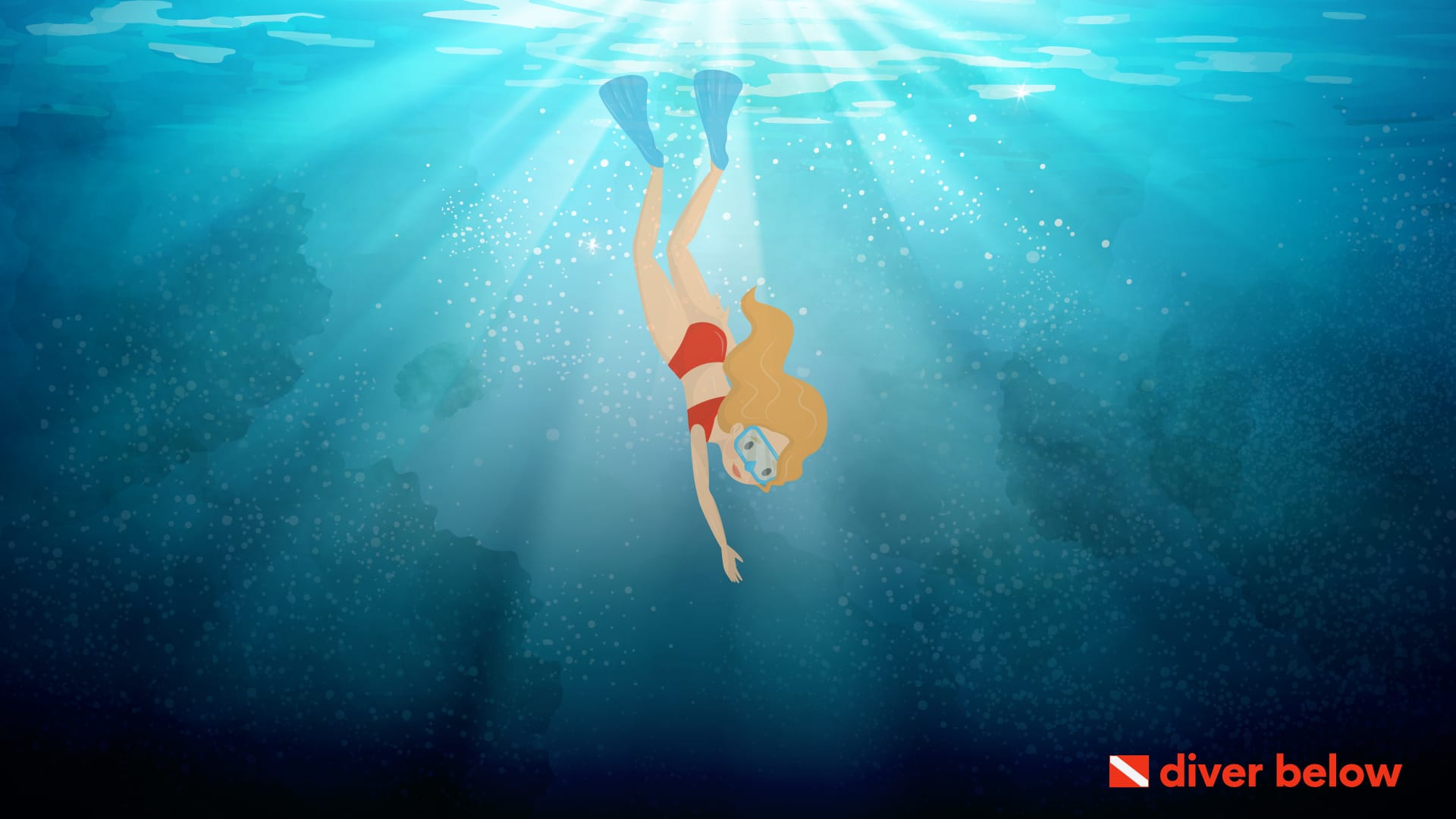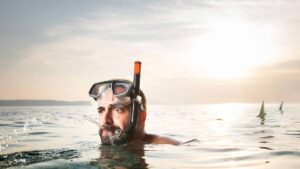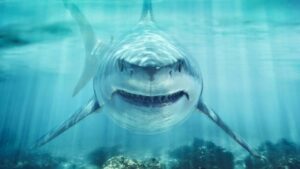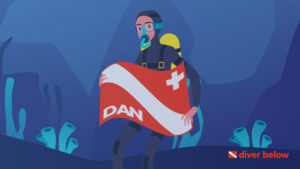Freediving began the first time a person on a boat dropped something overboard.
At some point, someone decided, “Maybe that thing isn’t lost forever. I could go in the water after it.”
Freediving is as old as people, for the most part.
Although, as a sport, it has come into its own over recent decades.
Evidence from South American mummies shows people freediving as long as 9,000 years ago.
Freedivers are also called skin divers. They love the peace and quiet of exploring the underwater world.
They also know that skin diving safely is important.
Safety means more than holding your breath and kicking toward the ocean floor.
Contents
- What Is Freediving?
- How Long Do Freedivers Hold Their Breath?
- Freediving vs. Snorkeling
- Types of Freediving
- Freediving Equalization
- Benefits of Freediving
- Is Freediving a Dangerous Activity?
- Is Freediving Bad for Your Health?
- What Does Freediving Do to the Body?
- Essential Freediving Equipment
- How to Start Freediving
- Frequently Asked Questions
- Wrapping Up
What Is Freediving?
At its most basic, freediving is almost the same as scuba diving.
This difference is that there’s no scuba tank breathing apparatus.
Freedivers often use masks and fins.
The main feature of freediving is the freediver’s breath-holding ability.
Just about anyone who’s been swimming has held their breath and gone under.
That’s all freediving is.
How Long Do Freedivers Hold Their Breath?
A Croatian man named Budimir Šobat held his breath for 24 minutes and a little more than 37 seconds in March of 2021.
This, as you may expect, set a world record.
He’s a freediver, but for this record, he wasn’t actively swimming around.
That would have burned more oxygen and created more carbon dioxide in his body and, in turn, would have shaved some time off that record.
The average person can usually hold his breath for between 30 seconds and two minutes.
Going much longer than that is possible, but it takes some practice, training, and effort.
Movie star Tom Cruise learned breath-holding techniques for a Mission: Impossible film.
He held his breath underwater for six minutes.
Kate Winslet went further.
She trained with a freediver and held her breath for more than seven minutes for the Avatar sequel.
These are celebrities, but they’re not world-class athletes.
The lesson here is that anyone can learn these breathing techniques.
Freedivers can expect, after training, to dive for a few minutes at a time.
Once you start getting close to ten minutes underwater, you’re really onto something.
Of course, longer breath-hold times allow divers to go deeper.
Like anything else, this takes training.
Before deep diving, freedivers need to work on a gradual depth progression.
They don’t just decide on a whim to see if they can reach the bottom.
Freediving vs. Snorkeling

How, you ask, is this any different from snorkeling?
It’s way different.
Both happen in the water, and participants in both sports usually wear masks and fins.
Other than that, they share little in common.
Even using the word “snorkel” as a verb rules out breath-holding.
Using a snorkel is to breathe air from the surface while sitting below that surface.
Freediving, sometimes called breath-hold diving, involves, well, breath-holding.
So, the two are very much different.
Snorkelers also rarely dive deeply enough to need pressure equalization.
If they do, they swim back to the surface, grab some more air through their snorkel, and go back under the water a few feet.
Types of Freediving
Like anything people get into, freediving methods have evolved.
Different freedivers take different approaches and pursue other goals depending on their specialties.
People freedive as a hobby or as competitive freedivers.
Either way, freediving can be highly specialized.
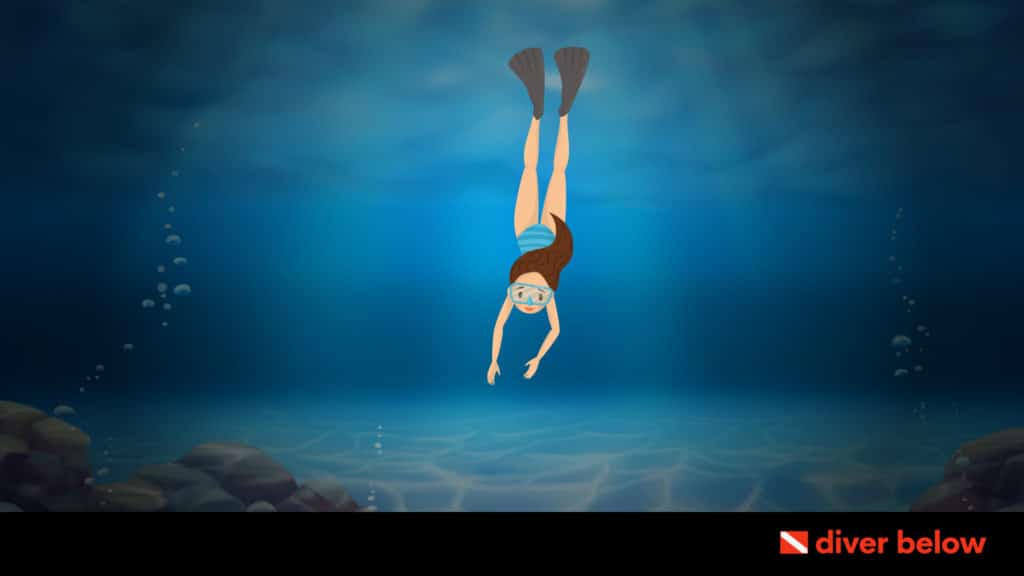
Competitive Freediving
Competitive freediving started as a bet.
In 1949, Italian diver Ennio Falco bet air force captain Raimondo Bucher that Bucher couldn’t freedive to a depth of 30 meters, a little more than 100 feet.
Falco lost the bet but dove even deeper a year later.
Different competitive freediving styles have developed since then.
There’s something for just about everyone.
Types of Freediving
The Confédération Mondiale des Activités Subaquatiques (CMAS) organizes competitions and recognizes different types of freediving.
Among these types are distance contests, depth contests, and breath-holding competitions.
For reference, “apnea” means “breath-holding.”
Static Apnea
Static apnea chases the longest breath-hold possible.
In competition, the static apnea diver isn’t concerned with depths or distances swam.
Static apnea is an event where the athlete aims to hold his breath for a predetermined amount of time or longer.
Dynamic Apnea
In dynamic apnea competitions, divers go for distance—all in one breath.
The diver who swims the farthest underwater wins.
There’s no predetermined racecourse. Instead, it’s just swimming as far as you can.
Subcategories in dynamic apnea include with or without fins.
Constant Weight
Constant weight freedives ask the freediver to swim as deep as she can.
“Constant weight” means that the diver does not take on extra weight to shed at the bottom of the dive.
Its cousin is variable weight freediving.
A diver takes a ballast down to a prescribed depth, drops it, and returns to the surface.
Free Immersion
Free immersion freediving is essentially constant weight freediving.
The difference is that divers do not use fins.
Other Kinds of Freediving
With all the specialization, there are many variations on freediving specialties.
While the list isn’t quite endless, there are many different kinds of freediving we haven’t touched on yet.
These include (but are not limited to):
- Speed-endurance apnea, which tests breath-holding and speed of swimming. The winning athlete swims the predetermined distance underwater in the fastest time.
- Jump blue competitions, a depth of about 30 feet. Usually held in open water, such as a lake or ocean, these events need fins. They are like speed-endurance apnea.
- Skandalopetra, which represents the beginnings of freediving. Competitors tie a rock to themselves to help them reach a certain depth.
Freediving Equalization
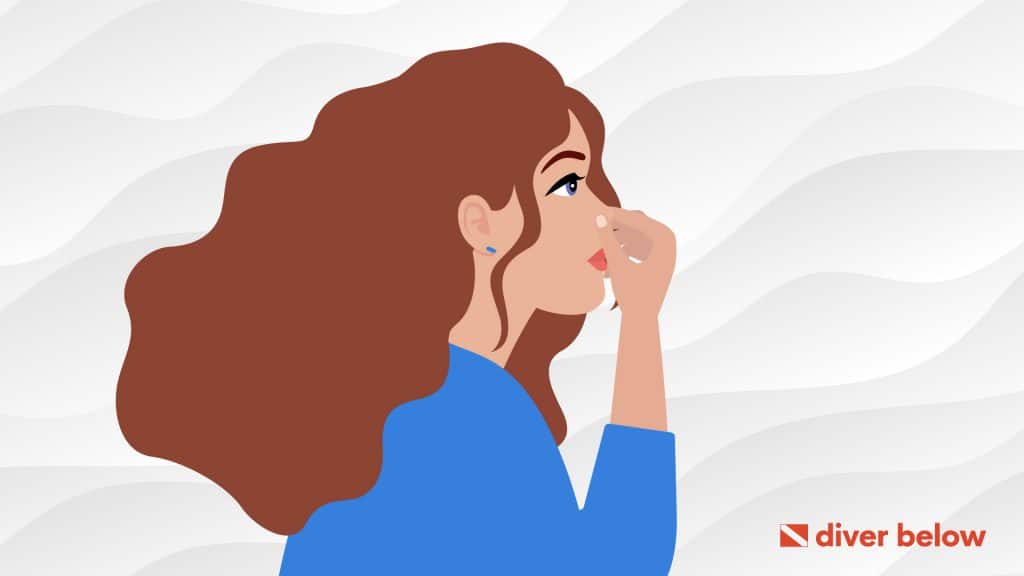
A scuba diver knows about equalization.
The deeper you go underwater, the higher the pressure, and it makes your ears hurt.
You hold your nose and gently blow air out.
You feel that incredible sensation of your ears popping.
This is when the pressure in your sinuses equalizes to the water’s atmospheric pressure.
You don’t have a steady air supply on your back as a freediver, so you can’t breathe in, blow out to equalize, and go back to diving.
Rather, you only have the air that you take with you in your lungs.
Freedivers learn things like the Frenzel maneuver.
This involves blowing air through a pinched nose and using the tongue to create pressure.
It’s complicated, and it’s not something many people figure out on their own.
This is something you learn from an instructor, which we’ll talk about in a bit.
Benefits of Freediving
Freedivers generally have lower stress levels, which can be a real plus in the world most of us inhabit.
This also means a freediver will be safer in the water if they find themselves in a dangerous situation.
There are other things that make one a successful or accomplished freediver.
These include the ability to focus, better cardiovascular health, and better oxygen efficiency.
All those things transfer to a better and healthier life out of the water.
So, it stands to reason that freediving is good for you.
Is Freediving a Dangerous Activity?
Yes. Yes, it is. Consider these things:
- The ocean is inherently dangerous.
- Holding your breath means depriving your body of oxygen. No human being has ever been able to live without it.
- The pressure a freediver subjects himself to is stressful on the body and its organs. Put your organs under enough stress, and they will fail.
- About one in 500 hobby freedivers dies every year. Competitive freedivers have a death rate closer to one in 5,000. Getting into extreme depths only increases the risks.
Most fun things can be dangerous.
Without proper training, gear, and instruction, freediving can quickly turn deadly.
It’s not a sport people want to just jump into on a whim.
Is Freediving Bad for Your Health?
Freediving provides health benefits, but it can also be dangerous.
Decompression sickness (or “the bends”) can be deadly.
Long-term exposure to the depths can cause our bodies to begin adapting to the pressure.
The bones of our inner ears can start to change.
Also, the muscles in our eyes can start changing to allow for tighter pupil constriction.
This change allows for better sight underwater.
These changes can be great for freediving but can damage our ears.
This can impair our hearing long after we’ve given up freediving for good.
What Does Freediving Do to the Body?
In addition to some of the changes mentioned above, freediving can affect your brain.
Without oxygen, the brain begins suffering damage and can result in death.
Understand that holding your breath does not cause brain damage.
But freediving can be very dangerous. Freedivers often push themselves to go deeper, stay under longer, and swim farther.
Trying to exceed their limits can cause long-term issues or death.
Essential Freediving Equipment
An important piece of freediving gear is a wetsuit.
You can freedive in a regular bathing suit, but having a wetsuit allows you to dive in colder water for a longer time.
Hypothermia can set in even in water as warm as 80 degrees.
Don’t assume that if there’s no ice in the water with you, you’re safe.
A wetsuit will help combat this.
Other equipment that many freedivers rely upon can make your freediving experience safer.
It can also be more enjoyable and will help you see better, dive farther, and go deeper.
- A weight belt means you won’t have to spend a large amount of energy getting down to and maintaining your position at depth. You can manage your buoyancy better, as well.
- A snorkel can make your breathing more efficient. When you surface, you won’t have to bring your head out of the water.
- A mask is almost a necessity. You can dive without one, but that will compromise your vision. If you’re diving in the ocean, opening your eyes in salt water can cause some physical discomfort for some.
- Fins aren’t necessary, though most freedivers use them. There are freediving competitions with categories that prohibit using them. But diving with fins means more speed. You reach your desired depth more quickly, meaning you’ll be able to spend more time down there.
- A dive gauge will let you know how deep you’ve gone and how long you’ve been there. You can live without this gear, but having one on your wrist allows you to have more information.
How to Start Freediving
Do not jump in the ocean and see what this whole breath-holding thing is and how deep you can go before you pass out.
Doing so is asking for trouble—actual, physical danger.
Invest some time in training from a group like the Professional Association of Diving Instructors (PADI).
The PADI Basic Freediver course addresses some fundamental techniques you’ll need to freedive safely.
These courses include classwork and a confined water session or two in a pool.
You’ll also have at least one open water session.
There’s also a PADI Advanced Freediver course.
Check with your local dive shop for PADI courses.
How Long Does It Take to Learn Freediving?
The PADI Freediver course takes about 15 hours total to complete.
After that, you’ll spend your whole life as a freediver learning and improving.
You’ll learn how to use the equipment as well as diving and breath-hold techniques.
Can I Teach Myself to Freedive?
Imagine that you decided to take up golf, having never played before.
You probably wouldn’t buy some clubs, head to the course, and start whacking away at balls.
You wouldn’t assume you’d be able to figure it out for yourself. Bad golf is very unlikely to kill you.
It would be best if you didn’t do this with freediving, either.
Freediving incorrectly can kill you.
You’ll want to do some training before you make your first attempt at 25 meters on a single breath.
Take a PADI course.
Freediving Certifications
We mentioned PADI certification earlier.
There is also the National Association of Underwater Instructors (NAUI).
They offer a freediving course, too.
There’s no hierarchy, either.
There’s no discussion of whether your PADI certification is better than your friend’s NAUI freediving certification.
What matters is learning how to engage in the sport safely.
Frequently Asked Questions
We’ve covered a lot of information, but we can never cover everything in a space like this.
Here are some of the more common questions people pose about freediving.
What is the record for freediving?
Freediving master Herbert Nitsch holds the top four records for freediving, reaching depths of 172 meters (564 feet), 183m (600ft.), 185m (606ft.), and 214m (702ft.).
That last one is longer than two football fields.
Do I need to know how to swim to freedive?
One hundred percent yes, especially if you’re diving in the ocean.
The ocean is not the place to learn how to swim, and if you can’t swim, wanting to freedive seems like a weird thing.
Do not try freediving if you cannot swim. Your chances of dying will skyrocket.
Without at least adequate swimming skills, you should focus on improving your swimming.
Do that before attempting any kind of diving.
How old do I need to be to start freediving?
NAUI certification requires that a freediver be at least 12 years old.
The PADI prerequisite is 15 years.
Did you ever hold your breath underwater at the neighborhood pool?
You were freediving then, and we all did that before our 12th birthday, right?
Wrapping Up
Freediving can be a peaceful, relaxing pastime or a limits-pushing competition with yourself and others.
It can be dangerous, too, though, so proper training is crucial.
However, most freedivers treasure their time under the waves.
Knowledge is power, so before you do anything, visit DiverBelow.com to learn all you can about freediving techniques, certification, gear, and safety.
